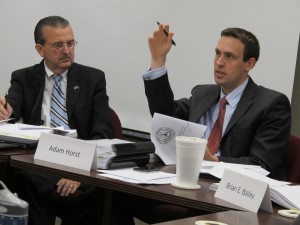Why Most Indiana Districts Would Rather Cut Budgets Than Ask For State Help

Kyle Stokes / StateImpact Indiana
A student at Crawfordsville's Hose Elementary uses a computer in the school's media center. The district has zeroed out its technology fund and made other cuts to make up for revenues they lost because of Indiana's property tax caps. Hose teachers say computers at the school are breaking down.
As a mechanism for tax reform, Crawfordsville Schools business director Scott Bowling says property tax caps are “a blunt instrument when perhaps a scalpel would’ve been a better tool.”
Crawfordsville Schools lost out on $1.2 million this year because of the caps, forcing Bowling to completely drain the district’s technology budget, among other cuts, to cover their expenses.
Crawfordsville’s tax cap losses were severe enough for the district to qualify for help from a state panel. The Distressed Unit Appeals Board, or DUAB, was recently reconstituted to offer loans and debt refinancing to districts the property tax caps had hit hardest. (We wrote more about the remedy itself here.)
But like all but three of the 35 other districts who were eligible for DUAB’s assistance, Crawfordsville officials did not apply for state help.
- 'I Can't Do Anything About 1993’ And Other Reasons Why Few Cash-Strapped Districts Are Applying For State HelpStateImpact Indiana‘s Kyle Stokes spoke to officials in Crawfordsville, where officials thought hard about applying for state help after the property tax caps’ hit to their budget, but ultimately decided against it.Download
That’s not to say Indiana districts aren’t feeling the caps’ impact on their bottom lines: Indiana’s 292 school corporations are losing a combined $195.3 million to the property tax caps this year. 42 districts — including Crawfordsville, Vincennes and Gary — saw losses of $1 million or more from their respective budgets.
The pain may be clear, but for many districts, the benefit of tapping DUAB’s remedies is not. Bowling says many districts believe they’ll continue to lose money to the property tax caps and DUAB’s remedies would only a temporary salve.
StateImpact Indiana‘s Kyle Stokes explains Indiana school districts’ ‘siloed’ budgets.
“We have accepted this as a new normal. At this point, the caps are in the [state] constitution,” Bowling says. He later added, “Most school districts would rather responsibly figure out a way to deal with their financial problems without being labeled a ‘distressed unit.’ We’re going to tackle this problem here at home, control it locally, solve it locally.”
The Districts That Are Getting Help
Two of the state’s most financially-troubled districts are taking advantage of DUAB’s remedies: Franklin Township restructured its debt (much like a homeowner might refinance her mortgage). Mount Vernon took out a loan from the state’s rainy day fund. Officials in Wayne Township’s school district are in the process of applying for DUAB’s help.
Before seeking state assistance, Franklin Township school officials had to make annual payments of $24 million to pay off the district’s debt. The district incurred most of that debt by building new schools to accomodate rapid student population growth.
With DUAB’s help, those payments have been lowered to $20 million annually. Though the new arrangement also means the district will ultimately end up spending more money to pay off its debt, Franklin Township finance director Chad Blacklock says the state panel’s help has allowed the district to make a 15- to 20-year plan to pay off its debt.
“It’s a long-term plan,” Blacklock says. “Property tax caps are here to stay, so we’ve got to make sure we’ve got a plan to make our debt payments and to fund transportation and do the necessary maintenance on our buildings.”
As we’ve explained, the expenses Blacklock mentions — debt payments, transportation costs and building maintenance — along with new school construction and technology costs are expenses districts often use property tax revenues to cover.
The Districts That Aren’t Getting Help
The state’s help comes with strings attached, however. In addition to a critical and public review of their finances by the state panel, districts would also have to get DUAB’s blessing for any building projects or renovations undertaken while they’re receiving state money.
Crawfordsville business manager Scott Bowling says his district seriously considered joining Franklin Township in going before the Distressed Unit Appeals Board if not for a very specific circumstance. The district has only two payments left on the high school it built in 1993 — the district’s most burdensome outstanding debt. After this year, Bowling says Crawfordsville’s property tax revenues will cover most of the expenses the district needs to cover.
In the meantime, the district is using dollars from its general fund — normally used to cover “instructional expenditures,” such as staff salaries and classroom supplies — to cover the district’s property insurance bills and most technology expenses.
StateImpact reached out to a few other districts hurting because of the property tax caps and heard similar stories. Peru Community Schools has reduced hours for custodians to cover their losses. Scott County School District 1 has eliminated teaching positions through attrition.

Kyle Stokes / StateImpact Indiana
State budget director Adam Horst (right) and state Rep. Milo Smith, R-Columbus, ask questions of Franklin Township school officials at the first meeting of the Distressed Unit Appeals Board on September 20.
Bowling speculates there’s a fear among school districts that DUAB’s panel — staffed by state budget director Adam Horst; Rep. Milo Smith, R-Columbus; and three other appointed members — might not give district’s a “fair hearing.”
“When you look at the appointees to that board [DUAB], they don’t appear to be friendly to public schools, just to be quite honest. I know there’s a thought there that there might not be an openness to schools having any needs at all — that’s just the perception among school people right now,” Bowling says.
Horst says the property tax caps empower taxpayers to hold districts accountable for how they spend their money, mostly because the caps will require districts to ask voters for support should they wish to incur a major expense in the future. Horst told StateImpact he felt the process was created to give districts honest feedback that included advice they might not have wanted to hear:
I hope it’s more of an ongoing dialogue between the school and the board. No one’s under the pretense, as far as I can tell, that this solves anybody’s problem. This is, at most, one piece of it — and you can argue whether or not it’s a productive step. But it’s clearly not going to solve their problems, so they’re going to continue to work at this. I hope the input that the board can provide can give them either ideas or the courage to make some difficult decisions so they’re not put in this position when they don’t have this option available to them.
A Solution In Search Of A Problem?
But if districts who qualify for a state remedy — supposedly crafted to help the districts hit hardest by the property tax caps — are able to better solve their budget problems on their own, was there ever a real problem with the property tax caps in the first place? Bowling answered that question this way:
If this was going to be our fate to lose this kind of money for even five years — we looked closely at it just being a year-and-a-half [until Crawfordsville High School’s debt is retired] — but even five years, we would’ve gone ahead and done it [applied for DUAB’s remedy]. We would’ve felt like pride issues get put aside so that the kids could have what they needed. I suppose there is an argument to be made that schools are looking creatively for ways to meet their budgets without having to get more money, and that could be true in certain circumstances…
Long term, debt usually equates to school buildings. School buildings usually last a long time. But even if you see your way clear, I think that the problem that’s going to come in the State of Indiana… I think we’ve probably forestalled some pain because… eventually you are going to have to do either do a massive renovation or build a new school or something like that, and that requires debt instruments. And if you can’t get a referendum passed, you’re going to see crumbling schools in the state of Indiana. It’s going to take a while, but ten years from now, I think you see that pain moreso than what you’re going to see in the near term.
Podcast: Play in new window | Download


